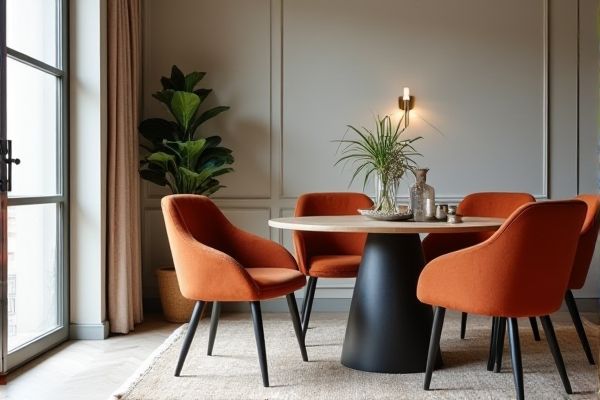
Fabric dining chairs offer breathable comfort and a wide range of colors and patterns that easily match diverse decor styles, while leather dining chairs provide a sleek, durable surface that is easy to clean and ages with character. Explore this article to discover which option best suits Your dining space and lifestyle needs.
Table of Comparison
| Feature | Fabric Dining Chair | Leather Dining Chair |
|---|---|---|
| Material | Woven textiles like cotton, linen, or synthetic blends | Genuine leather or PU leather |
| Comfort | Soft, breathable, comfortable for extended sitting | Smooth surface, can feel firm but molds over time |
| Durability | Moderate; prone to stains and wear but repairable | High; resistant to spills and easy to clean |
| Maintenance | Requires regular cleaning and spot treatment | Wipes clean easily, less frequent deep cleaning needed |
| Style & Appearance | Variety of colors, patterns, and textures | Luxurious look with a sleek, smooth finish |
| Cost | Generally more affordable | Typically more expensive due to material quality |
| Suitability | Good for casual, cozy dining settings | Ideal for formal, elegant dining rooms |
Introduction to Dining Chair Materials
Fabric dining chairs offer a soft, breathable, and versatile option that complements various interior styles with numerous color and pattern choices. Leather dining chairs provide a sleek, durable, and easy-to-clean surface that adds a touch of luxury and sophistication to any dining space. Your decision between fabric and leather should consider factors like comfort preferences, maintenance needs, and the overall aesthetic of your dining area.
Aesthetic Appeal: Fabric vs Leather
Fabric dining chairs offer a wide range of colors, patterns, and textures, providing versatile aesthetic options that can complement various interior styles from casual to contemporary. Leather dining chairs exude a timeless, luxurious appeal with a smooth, sleek surface that enhances elegance and sophistication in dining spaces. While fabric chairs bring warmth and comfort through softness, leather chairs add a polished, high-end look with durable, easy-to-clean material.
Comfort Comparison: Fabric and Leather
Fabric dining chairs offer superior breathability and softness, making them more comfortable for extended seating, especially in warmer climates. Leather dining chairs provide a sleek, durable surface that adapts to body temperature but may feel cooler or stickier during hot weather. Both materials impact comfort through temperature regulation and cushioning, with fabric excelling in softness and leather in longevity.
Durability and Longevity
Fabric dining chairs offer moderate durability, with their longevity depending largely on the quality of the fabric and maintenance, as they tend to absorb stains and wear faster in high-traffic areas. Leather dining chairs provide superior durability and longevity due to their resistance to spills, scratches, and fading, making them ideal for families or frequent use. High-grade leather, especially full-grain or top-grain, can last for decades while maintaining its appearance and structural integrity.
Maintenance and Cleaning Requirements
Fabric dining chairs often require regular vacuuming and prompt stain treatment to maintain their appearance, as spills can penetrate fibers quickly. Leather dining chairs are more resistant to stains and can be cleaned easily with a damp cloth and occasional conditioning to prevent cracking. You should choose based on your willingness to perform routine fabric care versus the simpler upkeep leather demands.
Cost Analysis: Fabric vs Leather Chairs
Fabric dining chairs generally offer a more budget-friendly option with prices ranging from $50 to $200, making them ideal for cost-conscious consumers seeking variety in colors and patterns. Leather dining chairs often come at a premium, typically priced between $150 and $500, reflecting their durability, premium look, and ease of maintenance. When factoring in long-term value, leather chairs may justify the higher upfront cost due to their longevity and resistance to stains compared to fabric options that may require more frequent cleaning and replacement.
Suitability for Household Types
Fabric dining chairs offer superior breathability and comfort, making them ideal for homes with children or pets due to their resistance to scratches and softer texture. Leather dining chairs provide a sleek, durable finish that suits formal dining rooms and households prioritizing easy cleaning and a sophisticated aesthetic. Families seeking a combination of style and practicality often choose fabric for casual settings and leather for more polished environments.
Environmental Impact and Sustainability
Fabric dining chairs generally have a lower environmental impact than leather chairs, as they often use renewable or recycled fibers like cotton, linen, or polyester. Leather production involves significant resource consumption, including water and energy, and generates greenhouse gases through livestock farming. Choosing chairs made from sustainably sourced fabrics or eco-friendly materials helps reduce carbon footprints and supports sustainable manufacturing practices.
Style Versatility and Design Options
Fabric dining chairs offer greater style versatility with a wide range of colors, patterns, and textures that complement various interior design themes from modern to traditional. Leather dining chairs provide a sleek, timeless look often associated with luxury and durability, available in classic tones like black, brown, and tan. The design options for fabric chairs allow for easily updated aesthetics through reupholstering, while leather chairs emphasize a polished appearance that ages well with minimal maintenance.
Final Recommendation: Choosing the Right Dining Chair
Fabric dining chairs offer greater comfort and breathability, making them ideal for longer meals and family gatherings, while leather dining chairs provide a sleek, durable, and easy-to-clean option suitable for modern or formal dining rooms. Consider factors such as maintenance, style preferences, and household activity levels when choosing between the two materials. For high-traffic dining areas with children or pets, leather chairs are often more practical, whereas fabric chairs excel in cozy, casual settings requiring softer seating.
 homyna.com
homyna.com